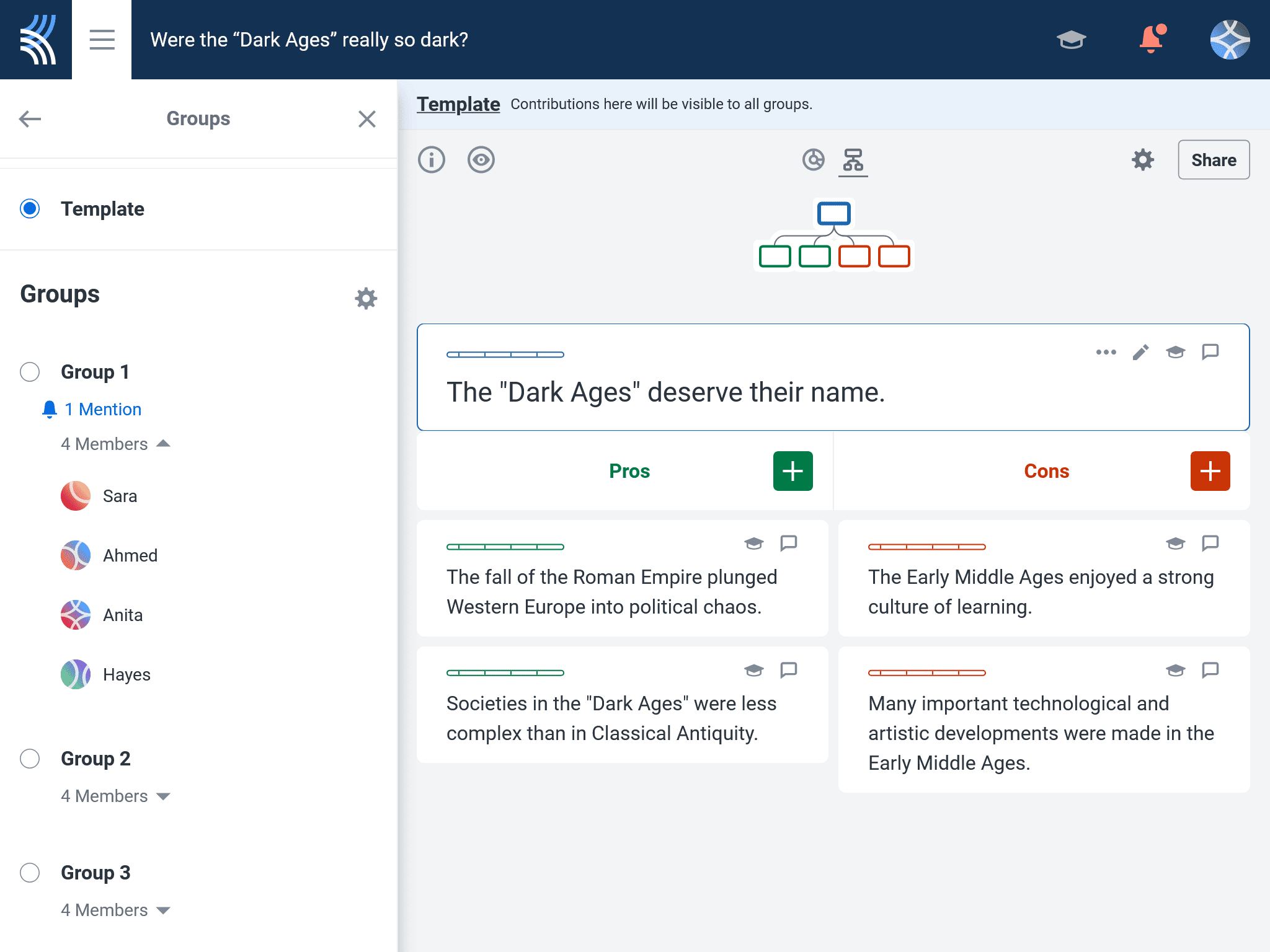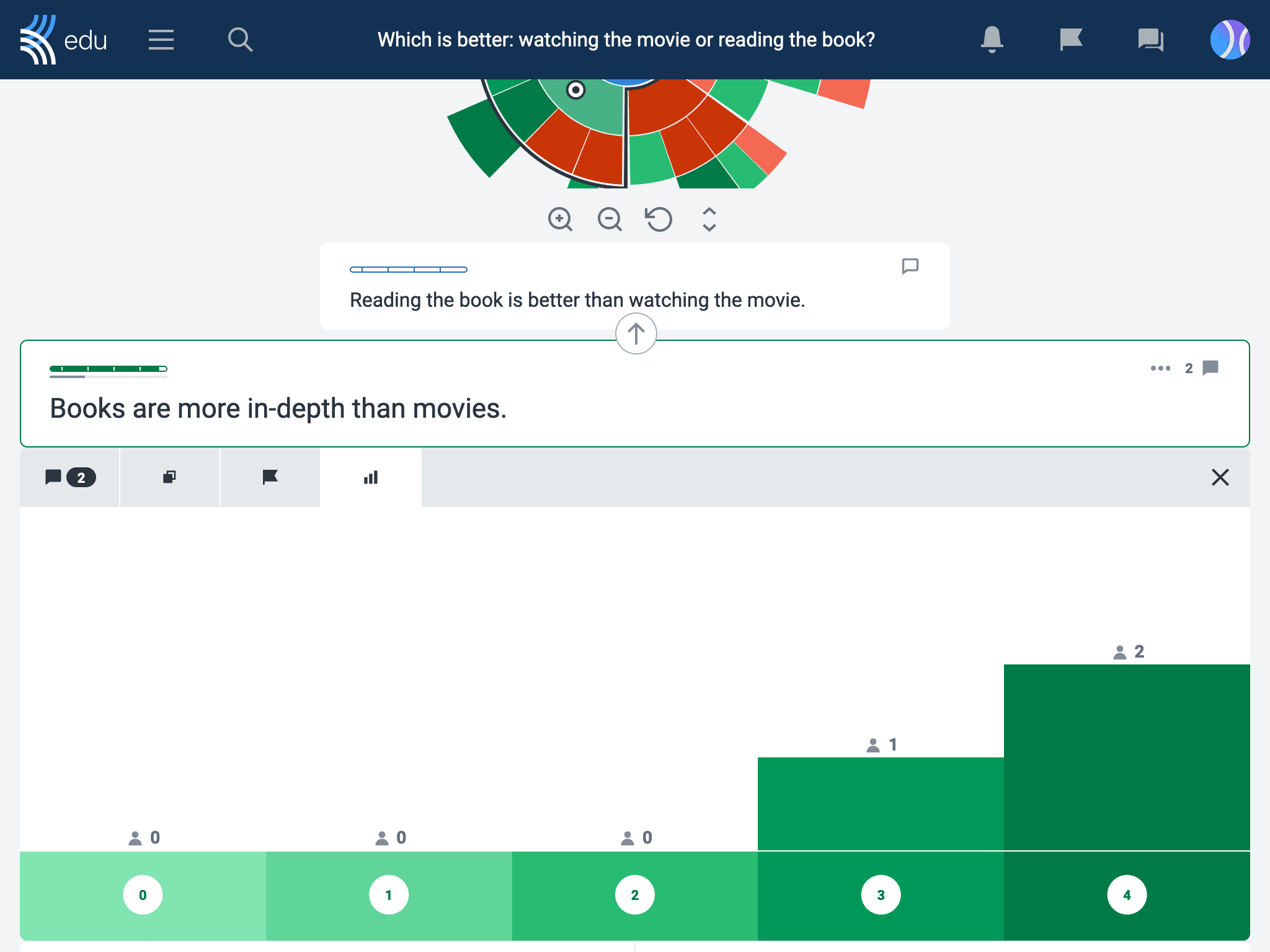Critical thinking is one of the most valuable skills students can develop to help them navigate their personal, academic, and professional worlds. By fostering these skills in the classroom, educators can ensure students don’t simply absorb information passively, but rather learn to question, analyze, and draw informed conclusions.
Try out these critical thinking activities on Kialo with your students to guide them to become 21st-century learners! As Kialo discussions help students visualize their thinking, students are better able to draw connections between ideas, challenge their own reasoning, and evaluate the strength of their arguments.
How to encourage critical thinking in the classroom
You can weave critical thinking into many types of activities, but here are some key types of activities that help students move beyond surface-level understanding. Use activities which contain the following attributes:
- Encourage active inquiry
- Promote curiosity
- Challenge assumptions
- Consider multiple perspectives and viewpoints
- Emphasize evidence and reasoning
- Foster collaboration
- Encourage reflection
- Engage in problem solving and decision making
- Use real world contexts and cross-disciplinary knowledge
- Foster metacognition
By incorporating such strategies, teachers can create an environment where students learn to question, evaluate, and synthesize information effectively. An added bonus is an improved classroom climate that encourages dialogue, diverse thinking, and peer learning. Students not only build self-awareness, but also develop the skills needed to think deeply and make informed decisions.
Critical thinking activities for the classroom on Kialo
Kialo discussions are designed to support critical thinking skills, encouraging students to think deeply, collaborate, and explore creative solutions to real world issues.
1. Identify logical fallacies and evaluate information

This activity explicitly addresses the flawed reasoning and misinformation commonly found in many online interactions.
Divide your class into groups, assigning each group a distinct thesis to discuss. Instruct each group to develop their discussion using both substantive pro and con claims, as well as some claims containing logical fallacies.
Students can also use this approach to practice evaluating evidence. Task them to include sources of varying quality in their discussion. You can adapt this to the level of your students; for beginners, this could mean including a mix of reliable and not-so-reliable sources, or simply omitting a needed source. More experienced classes might also cherry-pick or misrepresent information from reputable sources.
As they incorporate these fallacious claims or questionable sources, encourage students to name them and discuss how they weaken their arguments. To extend this activity, have each group peer review another group’s discussion to first identify the fallacies and problematic sources, and then rework the claims to make them stronger.
2. Analyze an influential argument
In this activity, students critically analyze a well-known argument to explore its layout, flow, logic, and approach.
Choose a famous argument, a political speech, or an opinion piece in a newspaper for groups of students to delve into. You can use Small Group Mode to streamline the process. This handy feature divides your class into groups, while you monitor each group working from a copy of a template discussion you create.

Then, have students map out the argument on Kialo, identifying the reasoning, central arguments, and supporting evidence the writer is citing as they go. Remind them that they can edit, and move and link their claims to different locations to refine the discussion as they work.
Next, have students vote on the claims and discuss their view on the argument. This helps students see how persuasive arguments are structured, while also giving them practice in articulating their own views clearly.

To extend this, have students return to the discussion from an opposing or simply neutral perspective to develop it further. This encourages perspective-taking and engagement with multiple viewpoints, which is crucial for gaining a deeper understanding of complex issues and fostering critical thinking.
3. Map out policy decisions
In this activity, students engage with real-world and meaningful issues that affect society through analyzing policy proposals. They’ll develop critical thinking skills and gain an understanding of political processes, enhancing their political literacy skills.
In this activity, students engage with real-world and meaningful issues that affect society through analyzing policy proposals. They’ll develop critical thinking skills and gain an understanding of political processes, enhancing their political literacy skills.
Choose a relevant policy for students to explore, or let them pick one as a group based on their common interests. Some relevant topics could be ones related to minimum wage laws, healthcare reform, or educational funding.
To prepare for the discussion, have students investigate the central intention of the policy, research the reasoning behind it, and find data, studies, and evidence to strengthen the case for its adoption. They then research the counterarguments and the different viewpoints on the policy.
Afterwards, have students input the information into a Kialo discussion to organize and visualize their analysis. This structure helps them better assess the strength of the policy and identify any unresolved claims.
To take it a step further, encourage students to seek out alternative policies or brainstorm different solutions. Then, use a multi-thesis discussion to give students a space to compare the different policy directions, sharpening their ability to weigh alternatives and synthesize information.
4. Roleplay a courtroom case
This activity blends debate and role play to encourage deep analysis of evidence and constructive dialogue.
Students first work in groups to explore a topic in-depth through a Kialo discussion. Let them know they’ll later have to represent and defend one side of the thesis (without revealing which) to ensure they examine both sides equally.
Students then form new groups of six, with two acting as experts and two as lawyers — one of each representing one side of the thesis — while the remaining two serve as jurors.
The experts present their knowledge on the thesis, while the lawyers question, encourage, and challenge their arguments. The jurors listen carefully, weigh the evidence, and identify any misrepresentation or bias before presenting their verdict and reasoning.
With each role, students will engage with the topic in different ways. Experts convey accurate and well-researched information, lawyers construct convincing and persuasive arguments, and jurors evaluate and summarize evidence. By giving all students the opportunity to articulate their understanding of the topic, this activity builds communication skills alongside critical thinking skills.
5. Reflecting on changes in thinking
This activity prompts students to explore how opinions are formed and evolve.
Start by instructing students to vote on a thesis before starting a Kialo discussion. Set the Voting visibility to “Users only see their own votes”’ to reduce peer influence and social pressure, so students feel free to be candid with their own votes.
Students then work in their groups to build their discussion. Alternatively, to further personalize this approach, you might ask students to each identify a strongly-held belief to explore in an individual discussion.
When your students have finished the discussion, ask them to revisit their vote again to see where their vote now lies on the Impact Meter, and whether their ideas have been reinforced or challenged. You can provide critical thinking questions to guide their reflection, such as:
- What was the turning point in the discussion?
- Did your opinion change?
- Were any of your assumptions challenged?
- What new perspective or information have you gained?
- What lessons can you take away from this activity?
By critically examining their own beliefs, students can recognize that changing one’s mind can be a sign of intellectual growth and that opinions can be reinforced and strengthened through evidence and deep analysis.

